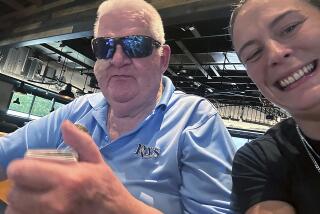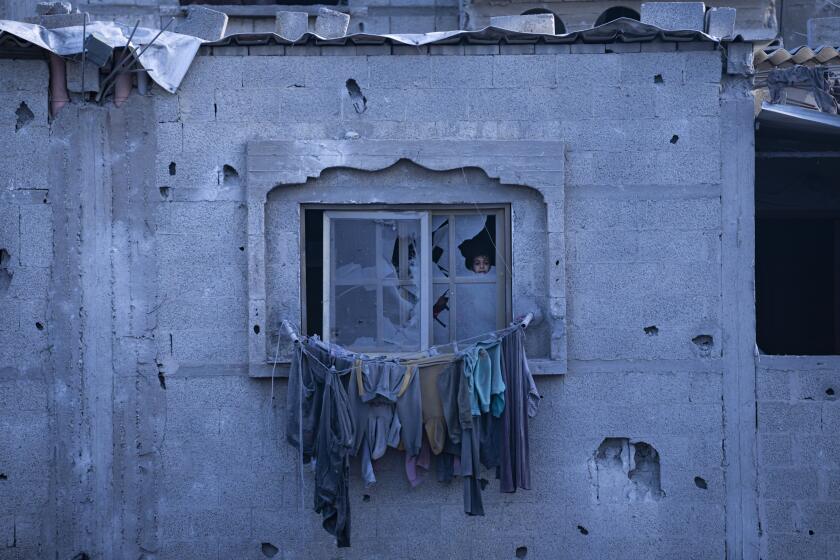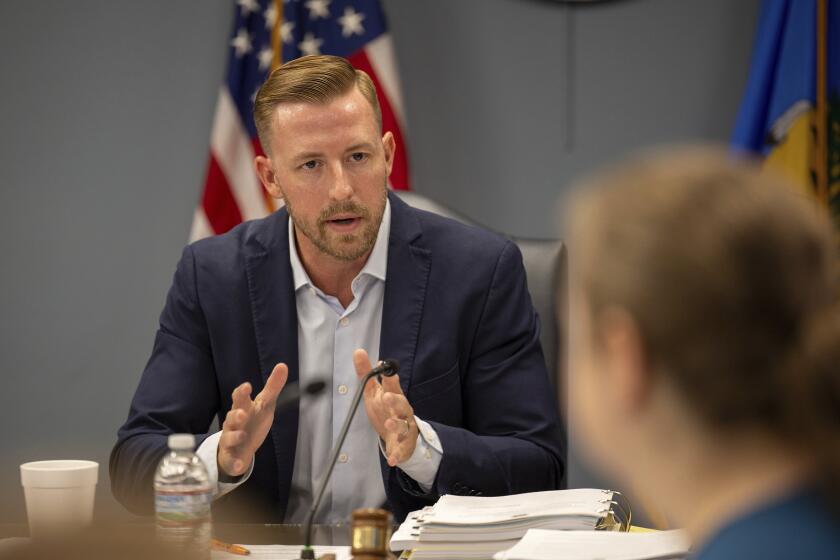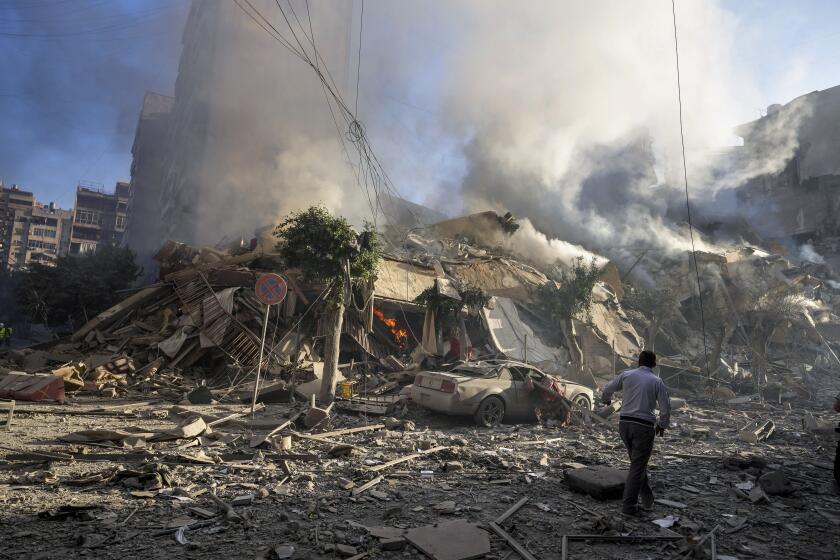COLUMN ONE : Taking the Cartels to the Cleaners : U.S. agents are squeezing drug lords by targeting money, not merchandise. The crackdown has forced a switch from high-tech laundering networks back to the risky smuggling of big caches of cash.
Export papers were all that distinguished the two rust-colored shipping containers from dozens of others waiting on a Brooklyn dock to be loaded aboard the Colombian freighter Loquimay.
They listed the cargo as dried split peas.
But veteran U.S. Customs Service inspectors Dean Jordan and Luigi Ruzza recalled seeing earlier shipments from the same Queens exporter to the same address in Medellin, Colombia--with one curious difference: The previous containers carried automobile parts.
Why would a Colombian auto parts importer be getting tons of peas?
The suspicious Customs Service officers drilled holes in the padlocked 20-foot containers. Peering inside, they could see stacks of 100-pound bags of the vegetable.
Then the inspectors noticed their drill bits. They were caked with a green, powdery substance, and it wasn’t split peas. It was residue from U.S. currency--$7.2 million in every denomination--that agents found stacked like bricks in a hidden chamber of the container.
The discovery last summer, and the resulting investigation by Customs Service and IRS agents, shut down a fledgling money-laundering operation based in New York that had funneled more than $80 million to the Medellin drug cartel and was spreading into Florida, Texas and Southern California.
It also told federal investigators that a five-year crackdown on drug money-laundering networks seemed to be working. Authorities were forcing the cartels to sacrifice more sophisticated electronic techniques for a return to riskier bulk transfers of currency to retrieve shares of the illegal drug trade--an estimated $334 million, most of it cash, generated every day in the United States and Europe.
“Maybe we’re driving them back to the Stone Age,” said Michael P. Fahy, head of financial investigations for the Customs Service in New York. “If the cartels have to move their profits in bulk cash, they’re more vulnerable. It’s not the way they like to do business.”
The slow, inefficient and risky bulk transfer of cash was common two decades ago, before the proliferation of electronic banking made it possible to slip billions of dollars into accounts around the world with the stroke of a computer key.
But federal officials say stricter disclosure rules and tougher money-laundering statutes--with penalties up to three times as severe as those for bank fraud--have turned banking officials into watchdogs for law enforcement and made the banking system less accessible to drug barons.
The trend away from electronic money laundering has been apparent in recent months with the discovery of other hidden bulk cash shipments in the New York region: $6 million found in refrigeration canisters used for transporting bull semen, $1 million in pallets containing boxes of strawberries, $14 million in the cores of massive cable spools, and millions more concealed in shipments of bicycles, water heaters and engine blocks.
“The criminal element is already afraid of the audit trail, and (lately) they can’t trust the banking system to look the other way like they used to,” Fahy said.
In part, his optimism springs from the early successes of such efforts as Operation El Dorado. The groundbreaking Treasury Department task force targeting the profits of international drug lords was launched in New York last year.
According to official statistics, El Dorado agents in their first six months seized more than $52 million in cash, arrested 128 suspected money launderers and dismantled financial networks responsible for processing hundreds of millions of dollars.
“I’m looking for the day when we take them down a billion dollars at a time,” said Robert E. Van Etten, a former Internal Revenue Service agent who heads the Customs Service field office in New York.
Operation El Dorado was Van Etten’s brainchild. The New York-based organization--coordinated jointly by local Customs Service and IRS agents--pooled the investigative, regulatory and intelligence-gathering resources of all branches of the Treasury Department. Van Etten said he expects it to become a national model.
Operation El Dorado’s tactical scheme, targeting the money rather than the narcotics, is part of a significant shift throughout law enforcement in its long, frustrating war on drugs.
For years, Customs Service agents focused on intercepting narcotics shipments at the nation’s borders. The FBI and the federal Drug Enforcement Administration targeted domestic and foreign distribution networks. Such efforts produced sensational headlines: highly publicized seizures of tons of contraband, arrests, convictions, stiff penalties and a national prison system jammed with drug-related convicts.
But all of this did not cripple the drug business.
“We got a lot of couriers, dealers, distributors--a lot of little guys,” Van Etten said. “But some of the biggest people in the narcotics trade never touch the stuff. To get them, you’ve got to go after the money. They do touch the money.”
Indeed, drug trafficking continues to be a booming business.
“It’s growing astronomically. It seems to be the one business that’s completely recession-proof,” said Thomas Loreto, another former IRS agent who now supervises El Dorado investigative teams for the Customs Service.
Official estimates of drug money laundering in the United States range from $10 billion to more than $100 billion a year. One report, compiled in 1990 by researchers from the seven leading industrial nations, said U.S. and European drug dealers earn about $14 million every hour.
Drugs enter the U.S. market on consignment. The cash proceeds of street sales then have to be returned to the drug lords, less the standard fees paid to those who facilitate its transfer.
That transfer process--from collection and accounting to the delivery and ultimate deposit into a legitimate account--is “the laundry.”
Drug money collected in the New York-New Jersey area, the money-laundering capital of the world, is first consolidated in local “cash houses,” where it is counted and bundled. Couriers contacted by beeper and cellular phone then pick up bags and boxes of currency for delivery to pre-assigned launderers: cooperative bankers, check-cashing operations or other seemingly legitimate businesses.
Loreto recalled one investigation that led to “a desperate” Eastern bank in the process of being closed by regulators because of financial irregularities. While surveillance agents followed shipments of drug money, they watched as couriers “would knock on the window and a bank official would let them in with boxes of cash.”
Sometimes, when heat from law enforcement is too great or if a booming drug business has produced too much cash at one time and place, the currency must be moved to distant regions.
Authorities say they have documented millions of dollars in transcontinental drug money transfers by hired armored cars or unsuspecting commercial carriers.
Of course, shipping illicit currency abroad is more hazardous because packages are subject to routine inspection by officials on both sides of the border. That is one reason the cartels prefer shortcuts directly into the U.S. banking system.
Investigators say couriers who deliver the bags of cash to the laundry keep between 0.25% and 1% of their haul, while the primary launderers, who transfer cash into the banking system, generally keep from 4% to 6% of the total. Even such small percentages can mean substantial commissions.
When Customs Service agents shut down one Manhattan jewelry district operator in 1990, they ultimately discovered that the man had laundered more than $100 million and pocketed an estimated $3 million to $5 million.
His cover was blown when a team of federal agents decided to analyze patterns of cash deposits in New York City.
Under federal law, banks are obligated to notify the Treasury Department of cash deposits exceeding $10,000. For a city the size of New York, such regulatory files produce massive amounts of data. But investigators armed with large computers narrowed their search to a single cash-rich neighborhood and launched an audit of currency reports.
Their first target: Manhattan ZIP Code 10036.
In an investigation that would be a trial run for Operation El Dorado, Customs Service and IRS agents identified the biggest cash depositors in the neighborhood. They found the New York Telephone Co., the New York Times, major Times Square retail stores--and Luis Roges, a small-time Cuban gold wholesaler in the jewelry district.
“We found records of $90 million in cash deposits, and we looked at each other and said: ‘Who the hell is this guy?’ ” said Customs Service investigator Thomas McMahon.
A federal jury was subsequently told that Roges received regular visits from Colombian drug couriers bearing hundreds of thousands of dollars. He would deposit the cash in his business accounts and then alter or fabricate invoices to make it appear they were legitimate business transactions.
For a time, investigators said, Roges even kept orders of gold circulating around the globe, shipping it between New York and South America so that if questions were raised about the money transfers, he could claim it was related to gold deals.
As the money-laundering business expanded--and no one asked any questions--he “got lazy and greedy” and dropped the gold charade, McMahon said.
Last summer, Roges was convicted of money laundering and sentenced to prison. He also forfeited $1 million frozen in business and personal bank accounts at the time of his arrest.
In another case, prompted by a tip from suspicious bankers, federal agents discovered a neighboring jewelry district businessman deeply immersed in money laundering. Surveillance teams found that he worked 18 hours a day, scurrying about with his laptop computer, managing cash transfers through an intricate web of accounts.
“His cohorts on 47th Street thought he was the hardest working guy in the area,” said one investigator. “He was doing so much business for the Colombians that he could hardly keep track of it all. He was getting behind. I think he was glad to be arrested.”
The man, a jewelry manufacturer, told investigators at the time that he was “only the 12th-biggest” money launderer in the city. Treasury Department auditors were later able to document more than $300 million in drug money processed by that single jewelry maker.
It was no accident that the New York jewelry district was targeted by the early federal probe: A joint federal-state investigation of the Los Angeles jewelry district had developed intelligence leads pointing to Manhattan.
As a result of the various investigations on both coasts, agents say they compromised 750 bank accounts.
“That’s 750 bank accounts they can’t use any more,” Loreto said. “But the cash keeps coming in, so they’ve got to find other ways to move it.”
Investigators have found that cartel money-laundering networks are operated much like terrorist organizations, with small cells of operatives functioning independently. Each cell has its specialists, and no one knows much about fellow conspirators--not even their real names.
In one El Dorado case, investigators monitored cash drops to a man known only as “El Gordo” made by couriers known only as “the Kid” and “Whiskers.” Other conspirators were “Zorro,” “Tigre” and “Flaco.”
Whole industries sprout to support the money-laundering enterprise. Investigators say check-cashing stores, paging services and automobile- and furniture-leasing offices have been linked to cartel operations.
“There are (transportation) charter companies set up that do nothing but move cash,” said one Customs Service official.
Cellular phones and paging beepers are essential tools of money launderers. It’s common, however, for the beeper users--usually the cash couriers--to have no idea who pays for the pager or who is responsible for the phone bills.
“The cartels buy the best brains in every field--banking, finance, leasing. They have specialists who do nothing but set up false identities or phony credit references,” said Michael O’Brien, a Customs Service investigator.
He was one of the first agents called to the Brooklyn docks last summer to help trace the $7.2 million in the split-pea shipment back to the laundering sources. O’Brien and partner Rose McNamara found more specialists.
“They had one guy running around the country doing nothing but getting warehouses” to store the specially modified containers, O’Brien said. The man used various names. Agents called him “the Welder.”
The Welder’s transcontinental travels, monitored by investigators, would lead to additional arrests in Miami and Southern California and the seizure of another $3 million in cash. O’Brien said the cell was also spreading into Texas, with operatives trying to set up more locations for modifying shipping containers to hide cash.
Once the first round of arrests was made, the web of connections linking the laundering cell to others beyond its tight circle immediately shriveled. A team of New York agents, raiding an upstate auto-leasing office that had provided one of the cell’s cars, found only a vacant space and a mystified landlord.
“The whole second floor was bare. There wasn’t a scrap of paper. The landlord had no idea when they left,” O’Brien said.
It was a typical defensive response by the criminal organization. The beeper numbers and cell phones were abruptly abandoned. The laundering cell not only died, it decomposed instantly.
But investigators did find a business ledger. Treasury Department analysts determined that in a matter of several months before the abortive split-pea export, the container shippers had moved about $80 million out of the United States.
“It’s typical to find individual cells handling $100 million or more,” Loreto said. “Think about that--you could probably buy the New York Giants for $100 million.”
In private, even the most optimistic investigators concede that so far they are inflicting only incidental damage on the lucrative harvest of drug profits. But if Operation El Dorado lives up to expectations, it could one day add substantially to cartel overhead.
“Our only mission,” Fahy said, “is to disrupt, penetrate and destroy all aspects of money laundering--to make the cost of doing business in the drug trade very, very high.”
More to Read
Sign up for Essential California
The most important California stories and recommendations in your inbox every morning.
You may occasionally receive promotional content from the Los Angeles Times.










